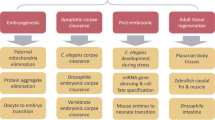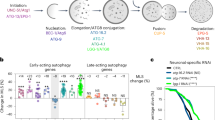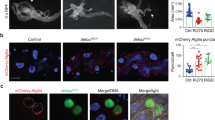Abstract
Autophagy is a self-degradative process involved both in basal turnover of cellular components and in response to nutrient starvation or organelle damage in a wide range of eukaryotes1,2,3. During autophagy, portions of the cytoplasm are sequestered by double-membraned vesicles called autophagosomes, and are degraded after fusion with lysosomes for subsequent recycling4. In vertebrates, this process acts as a pro-survival or pro-death mechanism in different physiological and pathological conditions, such as neurodegeneration and cancer2,5,6,7; however, the roles of autophagy during embryonic development are still largely uncharacterized3. Beclin1 (Becn1; coiled-coil, myosin-like BCL2-interacting protein) is a principal regulator in autophagosome formation, and its deficiency results in early embryonic lethality8,9. Here we show that Ambra1 (activating molecule in Beclin1-regulated autophagy), a large, previously unknown protein bearing a WD40 domain at its amino terminus, regulates autophagy and has a crucial role in embryogenesis. We found that Ambra1 is a positive regulator of the Becn1-dependent programme of autophagy, as revealed by its overexpression and by RNA interference experiments in vitro. Notably, Ambra1 functional deficiency in mouse embryos leads to severe neural tube defects associated with autophagy impairment, accumulation of ubiquitinated proteins, unbalanced cell proliferation and excessive apoptotic cell death. In addition to identifying a new and essential element regulating the autophagy programme, our results provide in vivo evidence supporting the existence of a complex interplay between autophagy, cell growth and cell death required for neural development in mammals.
This is a preview of subscription content, access via your institution
Access options
Subscribe to this journal
Receive 51 print issues and online access
$199.00 per year
only $3.90 per issue
Buy this article
- Purchase on Springer Link
- Instant access to full article PDF
Prices may be subject to local taxes which are calculated during checkout




Similar content being viewed by others
References
Lum, J. J., DeBerardinis, R. J. & Thompson, C. B. Autophagy in metazoans: cell survival in the land of plenty. Nature Rev. Mol. Cell Biol. 6, 439–448 (2005)
Levine, B. & Yuan, J. Autophagy in cell death: an innocent convict? J. Clin. Invest. 115, 2679–2688 (2005)
Levine, B. & Klionsky, D. J. Development by self-digestion: molecular mechanisms and biological functions of autophagy. Dev. Cell 6, 463–477 (2004)
Klionsky, D. J. The molecular machinery of autophagy: unanswered questions. J. Cell Sci. 118, 7–18 (2005)
Hara, T. et al. Suppression of basal autophagy in neural cells causes neurodegenerative disease in mice. Nature 441, 885–889 (2006)
Komatsu, M. et al. Loss of autophagy in the central nervous system causes neurodegeneration in mice. Nature 441, 880–884 (2006)
Edinger, A. L. & Thompson, C. B. Defective autophagy leads to cancer. Cancer Cell 4, 422–424 (2003)
Liang, X. H. et al. Induction of autophagy and inhibition of tumorigenesis by beclin 1. Nature 402, 672–676 (1999)
Yue, Z., Jin, S., Yang, C., Levine, A. J. & Heintz, N. Beclin 1, an autophagy gene essential for early embryonic development, is a haploinsufficient tumor suppressor. Proc. Natl Acad. Sci. USA 100, 15077–15082 (2003)
Huang, W. P. & Klionsky, D. J. Autophagy in yeast: a review of the molecular machinery. Cell Struct. Funct. 27, 409–420 (2002)
Qu, X. et al. Promotion of tumorigenesis by heterozygous disruption of the beclin 1 autophagy gene. J. Clin. Invest. 112, 1809–1820 (2003)
Shimizu, S. et al. Role of Bcl-2 family proteins in a non-apoptotic programmed cell death dependent on autophagy genes. Nature Cell Biol. 6, 1221–1228 (2004)
Boya, P. et al. Inhibition of macroautophagy triggers apoptosis. Mol. Cell. Biol. 25, 1025–1040 (2005)
Lum, J. J. et al. Growth factor regulation of autophagy and cell survival in the absence of apoptosis. Cell 120, 237–248 (2005)
Yousefi, S. et al. Calpain-mediated cleavage of Atg5 switches autophagy to apoptosis. Nature Cell Biol. 8, 1124–1132 (2006)
Clarke, P. G. Developmental cell death: morphological diversity and multiple mechanisms. Anat. Embryol. 181, 195–213 (1990)
Baehrecke, E. H. How death shapes life during development. Nature Rev. Mol. Cell Biol. 3, 779–787 (2002)
Lockshin, R. A. & Zakeri, Z. Apoptosis, autophagy, and more. Int. J. Biochem. Cell Biol. 36, 2405–2419 (2004)
Kuma, A. et al. The role of autophagy during the early neonatal starvation period. Nature 432, 1032–1036 (2004)
Komatsu, M. et al. Impairment of starvation-induced and constitutive autophagy in Atg7-deficient mice. J. Cell Biol. 169, 425–434 (2005)
Qu, X. et al. Autophagy gene-dependent clearance of apoptotic cells during embryonic development. Cell 128, 931–946 (2007)
Stoykova, A., Chowdhury, K., Bonaldo, P., Torres, M. & Gruss, P. Gene trap expression and mutational analysis for genes involved in the development of the mammalian nervous system. Dev. Dyn. 212, 198–213 (1998)
Skarnes, W. C., Moss, J. E., Hurtley, S. M. & Beddington, R. S. Capturing genes encoding membrane and secreted proteins important for mouse development. Proc. Natl Acad. Sci. USA 92, 6592–6596 (1995)
Kihara, A., Kabeya, Y., Ohsumi, Y. & Yoshimori, T. Beclin-phosphatidylinositol 3-kinase complex functions at the trans-Golgi network. EMBO Rep. 2, 330–335 (2001)
Kabeya, Y. et al. LC3, a mammalian homologue of yeast Apg8p, is localized in autophagosome membranes after processing. EMBO J. 19, 5720–5728 (2000)
Paglin, S. et al. A novel response of cancer cells to radiation involves autophagy and formation of acidic vesicles. Cancer Res. 61, 439–444 (2001)
Mizushima, N., Yamamoto, A., Matsui, M., Yoshimori, T. & Ohsumi, Y. In vivo analysis of autophagy in response to nutrient starvation using transgenic mice expressing a fluorescent autophagosome marker. Mol. Biol. Cell 15, 1101–1111 (2004)
Copp, A. J. Neurulation in the cranial region — normal and abnormal. J. Anat. 207, 623–635 (2005)
Liang, C. et al. Autophagic and tumour suppressor activity of a novel Beclin1-binding protein UVRAG. Nature Cell Biol. 8, 688–698 (2006)
Pattingre, S. et al. Bcl-2 antiapoptotic proteins inhibit Beclin 1-dependent autophagy. Cell 122, 927–939 (2005)
Heng, H. H. & Tsui, L., C. Modes of DAPI banding and simultaneous in situ hybridization. Chromosoma 102, 325–332 (1993)
Chowdhury, K., Bonaldo, P., Torres, M., Stoykova, A. & Gruss, P. Evidence for the stochastic integration of gene trap vectors into the mouse germline. Nucleic Acids Res. 25, 1531–1536 (1997)
Stoykova, A., Chowdhury, K., Bonaldo, P., Torres, M. & Gruss, P. Gene trap expression and mutational analysis for genes involved in the development of the mammalian nervous system. Dev. Dyn. 212, 198–213 (1998)
Ranga, U. et al. Cell and viral regulatory elements enhance the expression and function of a human immunodeficiency virus inhibitory gene. J. Virol. 71, 7020–7029 (1997)
Somia, N. V. et al. LFG: an anti-apoptotic gene that provides protection from Fas-mediated cell death. Proc. Natl. Acad. Sci. USA 96, 12667–12672 (1999)
Acknowledgements
We thank M. Torres and P. Bonaldo for their involvement in the large-scale gene-trap screening. We also thank A. Conrad for the mouse work, S. Hille for DNA sequencing, M. Acuña Villa and M. W. Bennett for editorial and secretarial work, P. Mattioli for help with image processing, and G. Lisi, and G. Bellavia G. Marchetti for research assistance. We are grateful to N. Mizushima for providing us with the GFP–LC3 mice. This work was supported in part by grants from the Telethon Foundation and Compagnia di San Paolo (F.C.), Ricerca Corrente and Ricerca Finalizzata from Ministero della Salute and AIRC (M.P.) and the Max Planck Society (A.S., K.C. and P.G.). We thank the Ministry of University and Research of Italy for financial support.
Author Contributions G.M.F., A.R., S.D.B., C.F. and M.C. performed the protein interaction and autophagy assays. A.S. and K.C. generated the Ambra1 gene-trap line and identified the tagged gene. A.S., L.G., K.C., R.N. and S.D.B. carried out the analysis of the phenotype. R.N. and P.S. performed electron microscopy. A.U. generated the Ambra1gt fusion construct. P.G.’s laboratory devised and performed the large-scale gene-trap screening. F.C., M.P. and G.M.F. wrote the paper. All authors discussed the results and commented on the manuscript.
Author information
Authors and Affiliations
Corresponding authors
Ethics declarations
Competing interests
The sequence for human AMBRA1 cDNA (Supplementary Fig. 1c) has been submitted to GenBank under accession number DQ870924. Reprints and permissions information is available at www.nature.com/reprints. The authors declare no competing financial interests.
Supplementary information
Supplementary Information 1
This file contains Supplementary Figures S1-S8 with Legends and Supplementary Table 1. (PDF 40771 kb)
Rights and permissions
About this article
Cite this article
Maria Fimia, G., Stoykova, A., Romagnoli, A. et al. Ambra1 regulates autophagy and development of the nervous system. Nature 447, 1121–1125 (2007). https://doi.org/10.1038/nature05925
Received:
Accepted:
Published:
Issue Date:
DOI: https://doi.org/10.1038/nature05925
This article is cited by
-
Genome-wide identification and analysis of WD40 proteins reveal that NtTTG1 enhances drought tolerance in tobacco (Nicotiana tabacum)
BMC Genomics (2024)
-
Autophagy: a necessary evil in cancer and inflammation
3 Biotech (2024)
-
Zebrafish ambra1b knockout reveals a novel role for Ambra1 in primordial germ cells survival, sex differentiation and reproduction
Biological Research (2023)
-
Nanomedicine for autophagy modulation in cancer therapy: a clinical perspective
Cell & Bioscience (2023)
-
Transcriptional regulation of autophagy and its implications in human disease
Cell Death & Differentiation (2023)
Comments
By submitting a comment you agree to abide by our Terms and Community Guidelines. If you find something abusive or that does not comply with our terms or guidelines please flag it as inappropriate.



